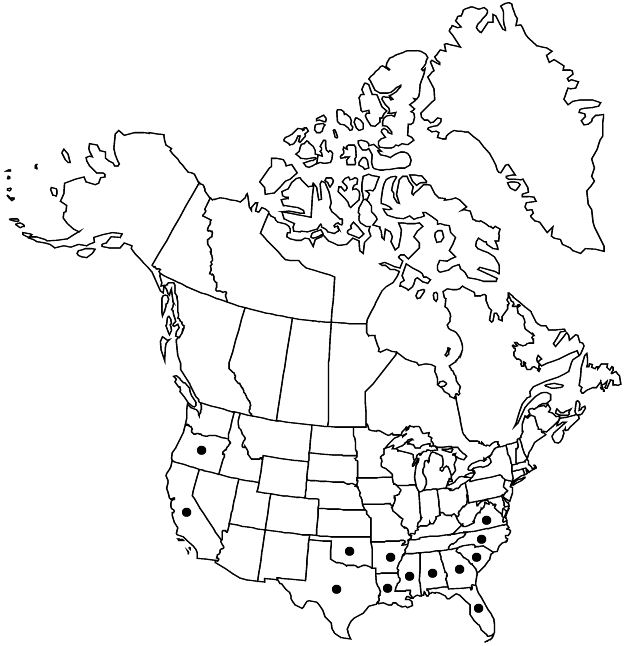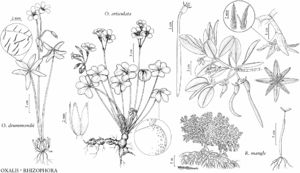Difference between revisions of "Oxalis articulata"
Encycl. 4: 686. 1798.
FNA>Volume Importer |
FNA>Volume Importer |
||
| Line 19: | Line 19: | ||
|name=Oxalis articulata subsp. rubra | |name=Oxalis articulata subsp. rubra | ||
|authority=(A. St.-Hilaire) Lourteig | |authority=(A. St.-Hilaire) Lourteig | ||
| − | }}{{Treatment/ID/Synonym | + | }} {{Treatment/ID/Synonym |
|name=O. rubra | |name=O. rubra | ||
|authority=A. St.-Hilaire | |authority=A. St.-Hilaire | ||
| Line 37: | Line 37: | ||
|elevation=0–250 m. | |elevation=0–250 m. | ||
|distribution=Ala.;Ark.;Calif.;Fla.;Ga.;La.;Miss.;N.C.;Okla.;Oreg.;S.C.;Tex.;Va.;South America (Argentina;Brazil;Uruguay);introduced also in Europe;Pacific Islands (New Zealand);Australia. | |distribution=Ala.;Ark.;Calif.;Fla.;Ga.;La.;Miss.;N.C.;Okla.;Oreg.;S.C.;Tex.;Va.;South America (Argentina;Brazil;Uruguay);introduced also in Europe;Pacific Islands (New Zealand);Australia. | ||
| − | |discussion=<p>Oxalis articulata in the United States commonly has been identified as O. rubra. Oxalis rubra was treated at subspecific rank by A. Lourteig (1982), but subsp. articulata and subsp. rubra have essentially the same native range and occur in similar habitats. Lourteig identified both subspecies in the United States, noting in her key that vestiture is reduced and the sepals are broader in subsp. rubra. Evidence is weak for recognizing more than a single entity. In the Flora of Panama (Lourteig 1980), she recognized only O. articulata, noting that it is naturalized in other parts of America and in the Old World.</p> | + | |discussion=<p><i>Oxalis articulata</i> in the United States commonly has been identified as O. rubra. <i>Oxalis</i> rubra was treated at subspecific rank by A. Lourteig (1982), but subsp. articulata and <i></i>subsp.<i> rubra</i> have essentially the same native range and occur in similar habitats. Lourteig identified both subspecies in the United States, noting in her key that vestiture is reduced and the sepals are broader in <i></i>subsp.<i> rubra</i>. Evidence is weak for recognizing more than a single entity. In the Flora of Panama (Lourteig 1980), she recognized only <i>O. articulata</i>, noting that it is naturalized in other parts of America and in the Old World.</p> |
|tables= | |tables= | ||
|references= | |references= | ||
| Line 62: | Line 62: | ||
|publication year=1798 | |publication year=1798 | ||
|special status=Introduced;Selected by author to be illustrated | |special status=Introduced;Selected by author to be illustrated | ||
| − | |source xml=https://jpend@bitbucket.org/aafc-mbb/fna-data-curation.git/src/ | + | |source xml=https://jpend@bitbucket.org/aafc-mbb/fna-data-curation.git/src/8f726806613d60c220dc4493de13607dd3150896/coarse_grained_fna_xml/V12/V12_150.xml |
|genus=Oxalis | |genus=Oxalis | ||
|species=Oxalis articulata | |species=Oxalis articulata | ||
Revision as of 14:43, 18 September 2019
Herbs perennial, acaulous, rhizomes present, thick, woody, irregularly nodulate-segmented, often covered with persistent petiole bases, stolons absent, bulbs absent. Leaves basal; petiole 11–30 cm; leaflets 3, green to purplish abaxially, green adaxially, rounded-obcordate, 18–20 mm, margins densely loosely ciliate, lobed 1/5–1/3 length, lobes apically convex, surfaces evenly strigose-villous to strigose-hirsute, oxalate deposits in dots concentrated mostly toward margins or over whole surface. Inflorescences usually umbelliform cymes, less commonly in irregular cymes, 3–12-flowered; scapes 12–28 cm, sparsely strigose. Flowers heterostylous; sepal apices with 2 orange tubercles; petals usually purplish rose to red, rarely white, 10–14 mm. Capsules ovoid, 4–8 mm, sparsely strigose. 2n = 42.
Phenology: Flowering Mar–Jul.
Habitat: Disturbed places, especially near gardens, lawns, fields, roadsides.
Elevation: 0–250 m.
Distribution

Ala., Ark., Calif., Fla., Ga., La., Miss., N.C., Okla., Oreg., S.C., Tex., Va., South America (Argentina, Brazil, Uruguay), introduced also in Europe, Pacific Islands (New Zealand), Australia.
Discussion
Oxalis articulata in the United States commonly has been identified as O. rubra. Oxalis rubra was treated at subspecific rank by A. Lourteig (1982), but subsp. articulata and subsp. rubra have essentially the same native range and occur in similar habitats. Lourteig identified both subspecies in the United States, noting in her key that vestiture is reduced and the sepals are broader in subsp. rubra. Evidence is weak for recognizing more than a single entity. In the Flora of Panama (Lourteig 1980), she recognized only O. articulata, noting that it is naturalized in other parts of America and in the Old World.
Selected References
None.
